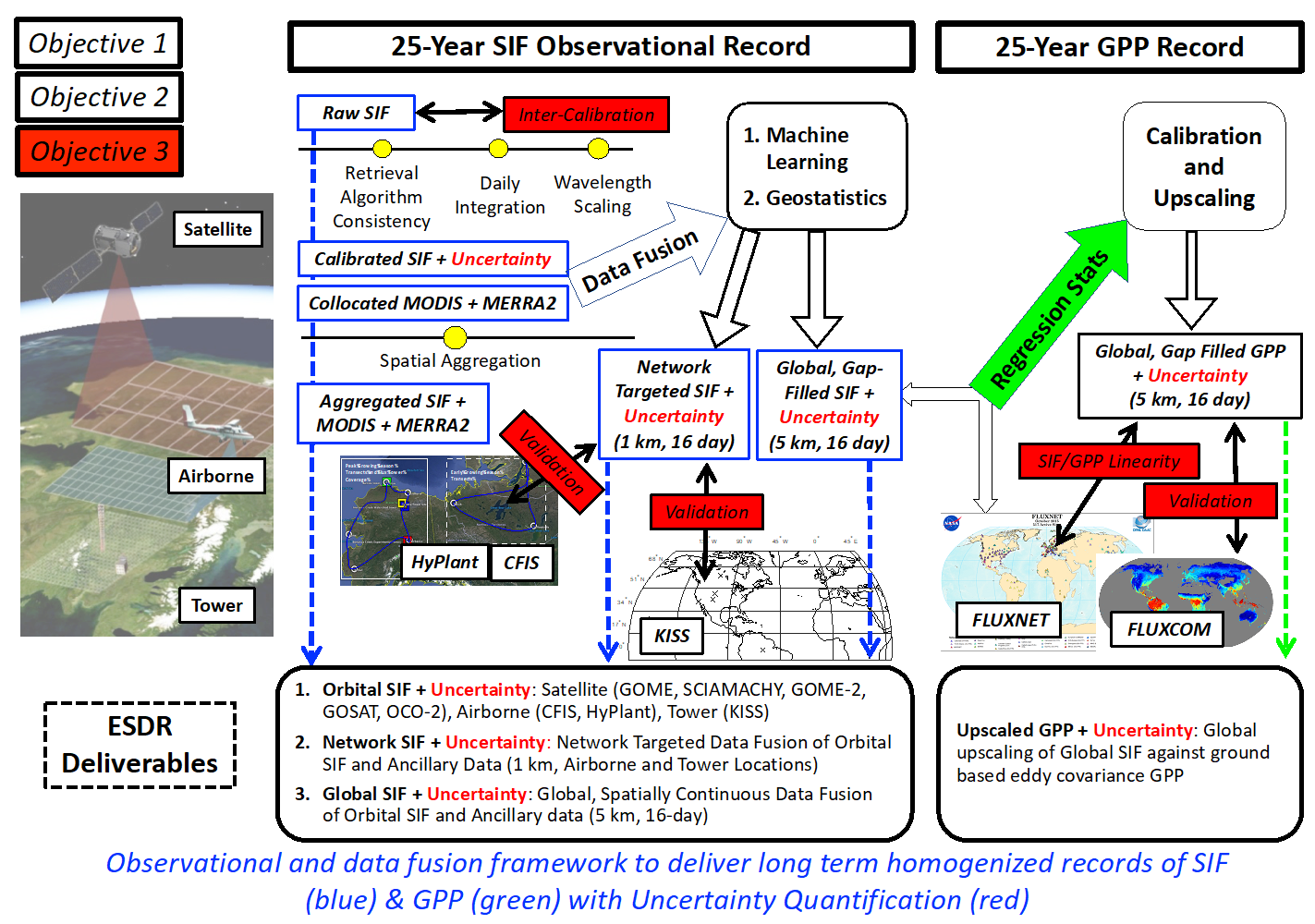Analysis Method

Our MEaSUREs SIF Earth System Data Record (ESDR) will deliver harmonized long term SIF and GPP records to realize three fundamental objectives. Our basic method and objectives are summarized in Figure 1.
Objective 1: Create a 25 year (1996-2020) global observation-based SIF ESDR. As the backbone of this work, we will create a harmonized SIF time series with bias corrections and radiometric calibration across multiple satellite sensors, and deliver instantaneous SIF and estimates of its daily integral to establish a continuous and calibrated record of long term SIF trends and variability. We will also merge calibrated SIF datasets with ancillary vegetation and environmental data to deliver a single, global spatially continuous SIF record at 5 km spatial and 16-day temporal resolutions, and network targeted SIF at airborne & ground towers.
Objective 2: Create a 25 year (1996-2020) global GPP ESDR based on upscaled SIF. We will quantify linear relationships between network targeted SIF records and ground GPP data at biome-diverse eddy covariance locations. We will create a global upscaled GPP record using linear relationships to scale spatially continuous SIF.
Objective 3: Deliver quantified uncertainties for the SIF and GPP ESDRs. We will provide uncertainties for all SIF and GPP products, accounting for error sources due to instrument, retrieval method, and data fusion, and from validation of SIF and GPP magnitudes and scaling assumptions against tower and airborne validation datasets.
Satellite SIF has become widely available in recent years from instruments such as GOSAT, GOME-2, SCIAMACHY and OCO-2 (Frankenberg 2011a,b; Guanter 2012; Joiner 2011, 2012, 2013), extending from 2002 with SCIAMACHY up to the present with GOME-2, GOSAT, and OCO-2. However, none of these satellite missions have been specifically designed for dedicated SIF measurements. Rather, SIF observations were enabled in a fortuitous manner as the spectral range covering the Oxygen A band at 760nm is often used in atmospheric remote sensing for cloud detection (Fischer and Grassl, 1991) and to account for scattering effects in the atmosphere. Their design parameters are thus optimized for the observation of atmospheric trace gas constituents rather than vegetation stress monitoring. For example, GOME-2 and SCIAMACHY provide long term (decadal) and high frequency (3-5 days) coverage, but at coarse native sampling footprints (40´40 and 30´120 km2, respectively). OCO-2 and GOSAT have small footprints (1.3´2.25 km2 and 10 km in diameter), but GOSAT’s sparse data acquisition and OCO-2’s narrow swath width prevents the continuous temporal and spatial mapping achieved by GOME-2. Differences of spectral resolution between sensors led to the development of distinctly different retrieval methods at high vs coarse spectral resolution (<0.05 nm: GOSAT, OCO-2; ~0.5 nm: GOME-2, SCIAMACHY), which prevents use of a single retrieval algorithm for all sensors . Additional complications arise in that each sensor provides only a single daily overpass (GOME-2 at higher latitudes is an exception), which prevents daily integration due to SIF diurnal hysteresis with changing light and stress conditions. Overpass times differ between sensors (morning for GOME-2 & SCIAMACHY; midday for GOSAT & OCO-2), which confounds cross-calibration. These differences create challenges for robust ground validation, radiance calibration, retrieval algorithm development and testing, and spatial and daily integration.
Development and expansion of the SIF tower and airborne network for the OCO-2 mission offers a unique opportunity for more spatially and temporally explicit study and cal/val of SIF. OCO-2 provides increased data acquisition, improved signal-to-noise, and a small ground footprint compared to GOSAT, GOME-1/2, and SCIAMACHY, for better biome sampling and more robust comparisons against eddy flux towers in its vicinity (Wood 2016, Verma 2017). Spectrally, spatially, and diurnally resolved airborne acquisitions from CFIS flights in 2015 and 2016 and coordination with OCO-2 overpasses and flux tower sampling provide a means to calibrate spaceborne SIF radiances and validate spatial gradients, anchored by direct calibration of OCO-2, as well as daily integration of satellite overpasses over diverse landscapes in N. America. Continuous measurements of canopy SIF since 2013 at towers in N. and S. America and Europe provide additional refinement and validation of daily integration under different light and environmental conditions. They are the primary means to validate seasonal/interannual variability and SIF-GPP relationships. Our approach in this research effort to develop and produce a multi-decadal SIF ESDR with well characterized uncertainty and error quantification is to use OCO-2 calibration to optimize the sampling strategies of GOME, GOME-2, SCIAMACHY, and GOSAT, and to anchor the production of a longer and spatially continuous SIF and GPP time series traceable to an expanding ground and airborne SIF validation network.
At the core of this effort lies reconciliation of an already extensive spaceborne SIF record. Despite substantial publication of individual SIF datasets (Sec 1.2.2.1), there exists known biases in current SIF products, and there has been no concerted attempt to compare or cross-calibrate both retrieval algorithms and post-processing strategies, such as the choice of reference targets or solar spectra. Thus, it is currently difficult to evaluate how inconsistencies across products affect scientific interpretation. Much of the initial effort in Years 1 and 2 will focus on retrieval algorithm testing and calibration, to validate consistency of methods and retrieved seasonal amplitudes for spectrally coarse sensors (SCIAMACHY, GOME-2) relative to OCO-2 and provide radiometric calibration and bias corrections (Co-I’s Frankenberg, Joiner, Koehler, Yoshida). As retrieval algorithms and sensors are established, Years 3 to 5 will focus on creating value added SIF datasets (Sec 1.2.2.2 & 1.2.2.3), development of GPP upscaling products (Sec 1.2.3), and SIF & GPP validation (Sec 1.2.4), including testing the SIF daily integral and validity of SIF-GPP linearity.